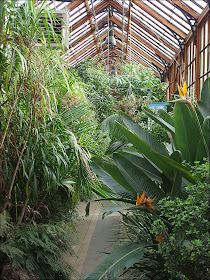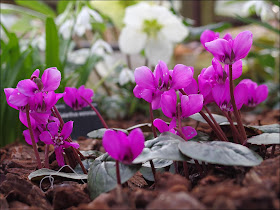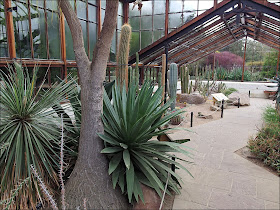February can be a bit chilly in the garden, but refuge can always be found in the Glasshouse Range at the Cambridge University Botanic Garden. The glasshouses are arranged with various bays to house plants from different parts of the globe, all kept at the correct temperature and humidity for the plants to thrive.
The Corridor
This is the corridor which links the different bays. As you can see there are many plants making their homes here and they, rather grudgingly, allow access to the intrepid explorer.
Continents Apart
The first bay we come to is dedicated to plants from South-West Australia and Southern Africa, two of the richest and most diverse botanical areas of the world.
Oceanic Islands
Plants arrived on isolated islands when their seeds were carried on ocean currents, by the wind, or by birds. Once established they then followed their own evolutionary course, over thousands of years, diverging from the mainland species from which they descended.
Mountains
In here all is cool and calm. These mountain plants are small, neat and colourful - and some of my favourites.
Tropical Rainforests
The central part of the Glasshouse Range is taller and more spacious, as it attempts to enclose the rampant growth of the rainforest plants. Children love being "in the jungle" and a few junior botanists were in attendance this morning. Meanwhile a much older photographer was trying to prevent the lens fogging up in the warm, humid air.
Tropical Wetlands
No respite from the humidity in here! Besides the rampant greenery there was also this striking Bromeliad in flower.
Arid Lands
The final bay contains plants from deserts including many types of cacti. Then you can either go directly back out to the garden, or you can fight your way back through the plants in the connecting corridor.
Take care.













This is obviously a place very close to your heart, John, and it is not hard to see why. In 2008 I spent almost a week in the Fynbos habitat of South Africa and was astounded at the diversity found there. And the beauty is overwhelming.
ReplyDeleteBeautiful! I am reminded of greenhouses at our Experimental Farm. One of them is open to public visits and has plants like these.
ReplyDeleteSuch a wonderful collection! Thank you for sharing it.
ReplyDeleteThis would be a wonderful place to live! Imagine having your morning coffee in the greenhouse. I suppose some people do... and, of course, we can just go outside when it's Spring, but it is cold and wet here now.
ReplyDeleteI sure would enjoy a visit to this place...it would be so good to be amidst all that green!
ReplyDeleteIt must be a real scientificendeavor to keep all those environments running correctly--even the arid lands. My goodnesss, what a lush place.
ReplyDeleteBeautiful place to be on a cold winter's day.
ReplyDeleteA walk through the world in one glasshouse. It looks a wonderful place to be on a chilly day:)
ReplyDeleteHi John - lovely to see the different areas of growth and the types of plants that thrive there. The kids must love the jungley feel ... while yes I can imagine the lens would get fogged up. I've always loved looking round The Eden Project's biomes ... but have yet to get back to Kew to see the new glass-houses there. Good to know there are budding scientists around - cheers Hilary
ReplyDeleteThat is really such a cool glass greenhouse. It really surprises me to see how many diverse species of plant that thrive in wildly different climates and terrains survive there. Truly grand.
ReplyDeleteA lovely place to walk and take in the beauty especially on a winter's dau.
ReplyDeleteA world of gardens in one building. What a job it must be to juggle all the needs!
ReplyDeleteI love when the orchids are blooming in the New Orleans Botanical garden.
Wow! I love all the different colors of green!!
ReplyDeleteWhat a treat John. I love glasshouses, especially 1920's greenhouses, not sure how old this one is? Our winters are fairly mild in Perth making the need for glasshouses almost non existent unfortunately ✨
ReplyDeleteI think it's a little older than that, probably late 19th century, though the central section is much more recent.
DeleteI love alpines too, so delicate looking yet often quite hardy plants. The rest looks like a jungle!
ReplyDelete